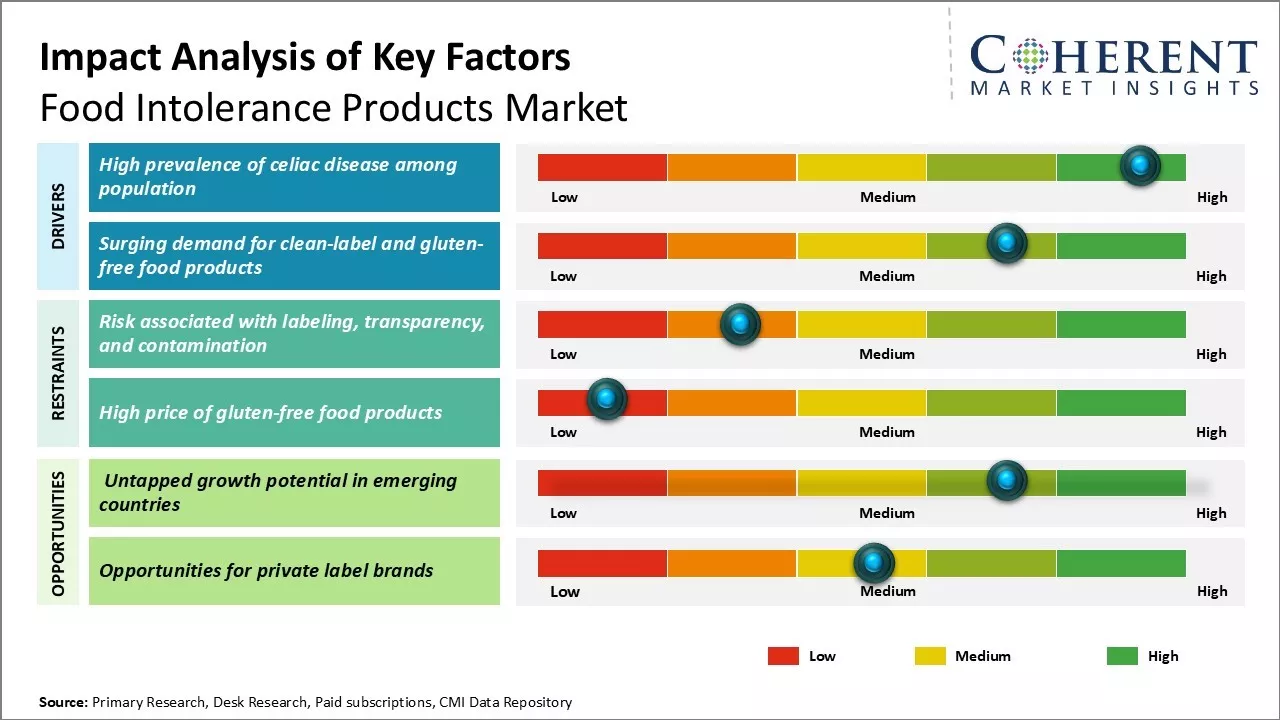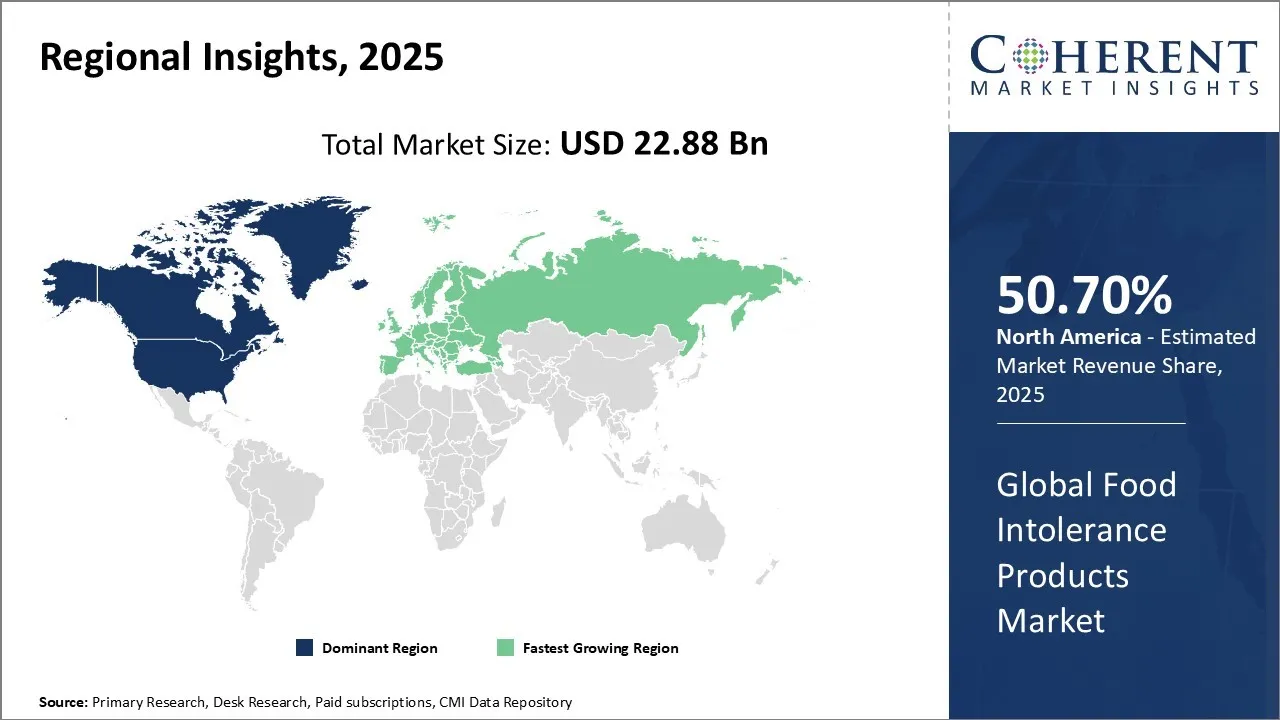The Food Intolerance Products Market size is estimated to be valued at USD 22.88 Bn in 2025 and is expected to reach USD 36.28 Bn by 2032, exhibiting a compound annual growth rate (CAGR) of 6.8% from 2025 to 2032. The market has been witnessing steady growth over the past few years driven by the rising prevalence of food intolerance disorders among consumers and growing awareness about the availability of specialized food products.

To learn more about this report, Download Free Sample
Factors such as increasing self-diagnosis of food intolerances, the availability of a wide range of food products without major allergens, and expansion of product portfolios by key companies such as General Mills Inc. and Chobani LLC are expected to contribute to the positive market trends. The emphasis on clean label and organic ingredients will also drive the growth of the Food Intolerance Products Market Demand through 2032.
|
Event |
Description and Impact |
|
Increasing Prevalence of Food Allergies and Intolerances |
|
|
Changing Consumer Preferences and Lifestyle Trends |
|
|
Technological Advancements in Food Manufacturing |
|
Uncover macros and micros vetted on 75+ parameters: Get instant access to report
In terms of product type, the bakery products segment is estimated to hold the highest Food Intolerance Products Market Forecast share of 42.7% in 2025 owing to strong consumer preference. Different types of sweet baked goods such as bread, cookies, and cakes form an integral part of many people’s dietary intake. Glucose, dairy free sweet bakery products, gluten free sweet bakery products. Compound diabetic sweet bakery products. Granulated sugar contains glucose, which many intolerant customers find difficult to manage with. Bakery items with reduced amounts of gluten compounds are growing immensely due to the sharp rise of demand. Basic elements in gluten free and lactose free bakery products make it possible for many intolerant customers to relish these popular edibles. Based on current trends, people are now becoming more weight conscious, preferring breads made out of millet to wheat. Popular brands sell a broad spectrum of products, from protein enriched breads to satisfy as many customers as possible. Chicken breasts sweeter than sugar Benefits, chicken breasts market with transformed formulation technologies assist in obtaining flavor and feel similar to traditional ones. It’s, therefore, the presence of these well engineered new bakery products satisfies these intolerant customers in a most delightful and crucial way. This segment is growing rapidly due to ease of intake and focus on taste coupled with addressing habitual consumption of products.
In terms of labeling type, the lactose-free food segment is estimated to hold the highest Food Intolerance Products Market Growth share of 35.8% in 2025 owing to strong consumer trust in the label. A large part of the population struggles with some form of lactose intolerance. Because of this, the lactose free label makes this category of consumers think that a lot of dairy nutritious foods like milk, yogurt, and cheese are available without the chance of major digestive issues later on. With regard to this, modern product development replaces lactose in cow’s milk with plant or goat milk which offers the same nutritional value. Hence, the barriers to consuming calcium, proteins, and other important body nutrients are removed. Such consumers will always be satisfied as long as the packages boast a prominent ‘lactose free’ label. This type of advertising will always encourage brands to keep investing into less popular and more innovative product lines. Alongside building brand trust, such advertising ensures these brands won’t be abandoned as new and unfamiliar product ranges get launched.
In terms of distribution channel, the online segment is estimated to contribute the highest Food Intolerance Products Market Outlook share of 55% in 2025 driven by supreme convenience it offers consumers. Research shows people with food intolerances particularly appreciate the accessibility and comfort of online shopping. They can shop from the safety of their homes without worrying about accidental cross-contamination risks at stores. Online retailers stock specialized products from a vast assortment under one virtual roof. Product samples and reviews assist finding perfect options. Contactless delivery furthers peace of mind during pandemic times.

To learn more about this report, Download Free Sample
North America is expected to account for the greatest Food Intolerance Products Market Value share, with 50.7% in 2025. Several North American countries have enacted policies promoting awareness about food intolerances. This supportive ecosystem has encouraged pioneering companies to launch versatile product lines catering to diverse needs.
The Europe region is experiencing the most rapid growth in Food Intolerance Products Market Trends, particularly in countries like the U.K. and Germany. Factors such as increased urbanization, rising disposable incomes, and a growing awareness of health issues are motivating consumers to gravitate towards specialized food products. Local firms are leveraging the demand by creating affordable options. International brands are also expanding their footprints across the region.
United States Food Intolerance Products Market Analysis and Trends
The U.S. market for food intolerance products remains highly dynamic, driven by innovation from both major food corporations and emerging startups. Customization, clean-label transparency, and consumer education play central roles in product development and marketing strategies. Increasing awareness around food sensitivities, combined with strong demand for gluten-free, lactose-free, and diabetic-friendly options, supports continuous product expansion. Regulatory guidance from bodies like the FDA also helps ensure quality and labeling consistency, fostering consumer trust.
Germany Food Intolerance Products Market Analysis and Trends
Germany leads the European market with a strong focus on product quality and safety in the food intolerance sector. Its long-standing legacy of pioneering specialty food brands, combined with strict regulatory standards, positions it as both a major importer and exporter. German consumers prioritize health and ingredient transparency, prompting brands to maintain high manufacturing standards and invest in innovation, especially in lactose-free and gluten-free segments.
United Kingdom Food Intolerance Products Market Analysis and Trends
The U.K. market benefits from robust collaboration between academic institutions and the food industry, leading to scientific advancements in intolerance-specific food formulations. Ongoing research in nutrition and food allergies has supported the development of credible, clinically backed products. Consumer adoption is further supported by a strong retail presence, including both mainstream and specialty brands that cater to evolving dietary needs.
India Food Intolerance Products Market Analysis and Trends
India presents significant untapped potential in the food intolerance products market, fueled by a diversifying middle class and rising health awareness. The government's investment-friendly policy environment, including initiatives supporting the food processing sector, encourages innovation and foreign investment. Although consumer demand is still emerging, increasing diagnoses of food intolerances and urbanization are creating new market opportunities.
China Food Intolerance Products Market Analysis and Trends
China is witnessing growing momentum in the food intolerance sector, propelled by rising health consciousness among urban populations and supportive trade policies. The government’s push for improved food safety and consumer education has contributed to increased demand for lactose-free, gluten-free, and other specialized products. Enhanced e-commerce infrastructure and cross-border trade reforms are opening new channels for both local and international brands.

To learn more about this report, Download Free Sample
Food Intolerance Products Market Report Coverage
| Report Coverage | Details | ||
|---|---|---|---|
| Base Year: | 2024 | Market Size in 2025: | USD 22.88 Bn |
| Historical Data for: | 2020 To 2024 | Forecast Period: | 2025 To 2032 |
| Forecast Period 2025 to 2032 CAGR: | 6.8% | 2032 Value Projection: | USD 36.28 Bn |
| Geographies covered: |
|
||
| Segments covered: |
|
||
| Companies covered: |
General Mills Inc., Conagra Brands Inc., Chobani LLC, Hain Celestial Group Inc., Danone SA, Amy's Kitchen Inc., Doves Farm Foods Ltd, Monde Nissin, Dr. Schär, Ecotone (Mrs Crimbles Ltd), and Arla Foods Amba |
||
| Growth Drivers: |
|
||
| Restraints & Challenges: |
|
||
Uncover macros and micros vetted on 75+ parameters: Get instant access to report
Celiac disease, also referred to as gluten-sensitive enteropathy, is characterized by the small intestine’s reaction to gluten through destruction upon its consumption. In striking changes, cryospheric disease is one of the conditions that have fascinated clinicians across the world over the past two to three decades. Approximately 1% of the global population suffers from Celiac disease, with a majority of them either partially diagnosed due to lack of information or due to slow progression of symptoms that leads to diagnosis at later stages within their lives. For instance, the Celiac Disease Foundation based on the National Institute of Diabetes and Digestive and Kidney Diseases stated that 1 in 100 people in the United States have an underlying celiac disease without awareness of the ailment. These statistics indicate that the rate of determining the spread of celiac disease compared to the actual figures is much lower than currently provided.
The market of food intolerance products has ample opportunities for growth within developing countries. On the other hand, Western developed markets have experienced growing acceptance for almost a decade now, but there are many developing countries that have yet to reach this stage. Countries such as India, Brazil, and Indonesia are observing an amply rising middle class that is poised to spend more due to an increase in income—this is creating a buzz around health-consciousness. This group will likely need specially designed food products that do not contain allergenic and intolerable ingredients. Manufacturing these products locally serves this purpose but does not raise costs for developing countries. First mover brands can expand as the developing markets are in need of awareness and growth, and this will allow them to gain volume in the longer run. Moreover, global companies can enter these regions as strategic partnerships and contract manufacturing via these market opportunities.
A global consumer survey of 5,000 participants revealed key trends in the consumption of food intolerance products. About 63% of respondents actively seek lactose-free or gluten-free options while shopping, and 48% consume these products despite lacking a formal diagnosis, largely due to perceived health benefits. Product labeling and certifications influence purchasing decisions for 72% of consumers, while 54% prefer buying online to access a wider variety and niche brands. The top motivations for using intolerance-specific products include digestive comfort (70%), allergy management (62%), and lifestyle or dietary preferences (40%).
Share
Share
About Author
Sakshi Suryawanshi is a Research Consultant with 6 years of extensive experience in market research and consulting. She is proficient in market estimation, competitive analysis, and patent analysis. Sakshi excels in identifying market trends and evaluating competitive landscapes to provide actionable insights that drive strategic decision-making. Her expertise helps businesses navigate complex market dynamics and achieve their objectives effectively.
Missing comfort of reading report in your local language? Find your preferred language :
Transform your Strategy with Exclusive Trending Reports :
Frequently Asked Questions
Joining thousands of companies around the world committed to making the Excellent Business Solutions.
View All Our Clients